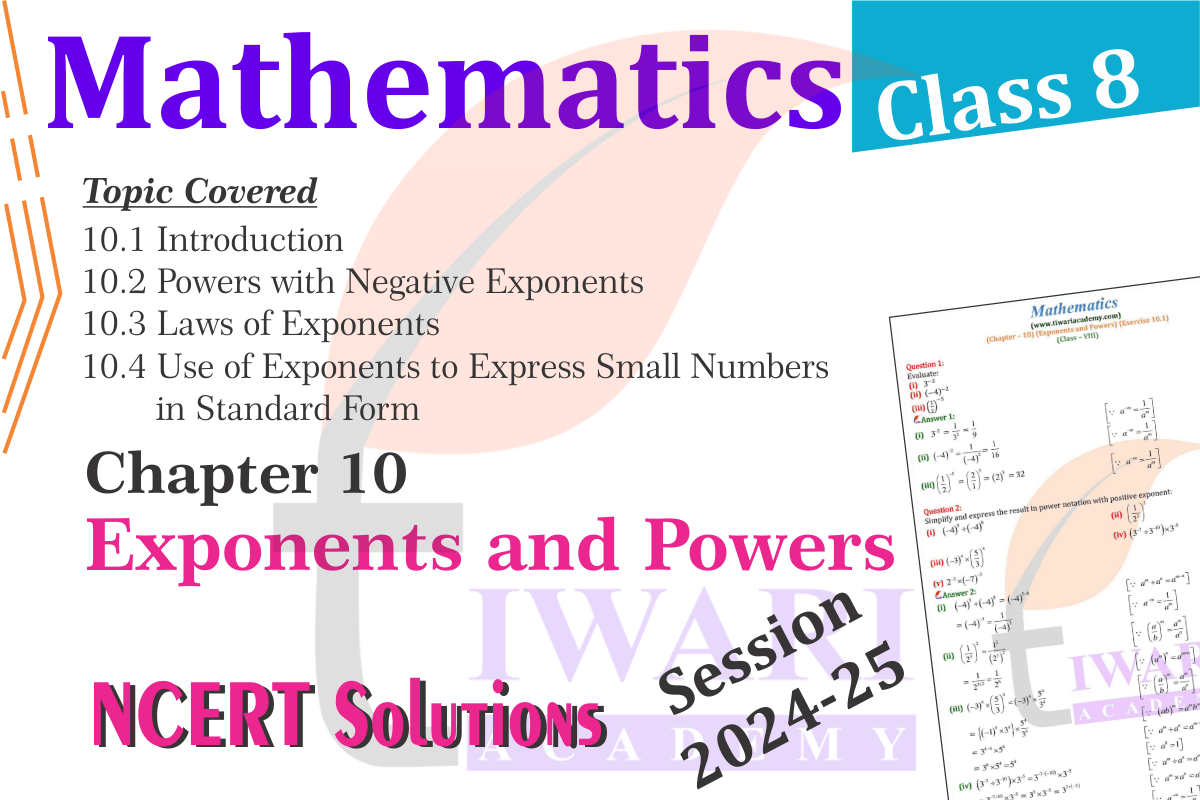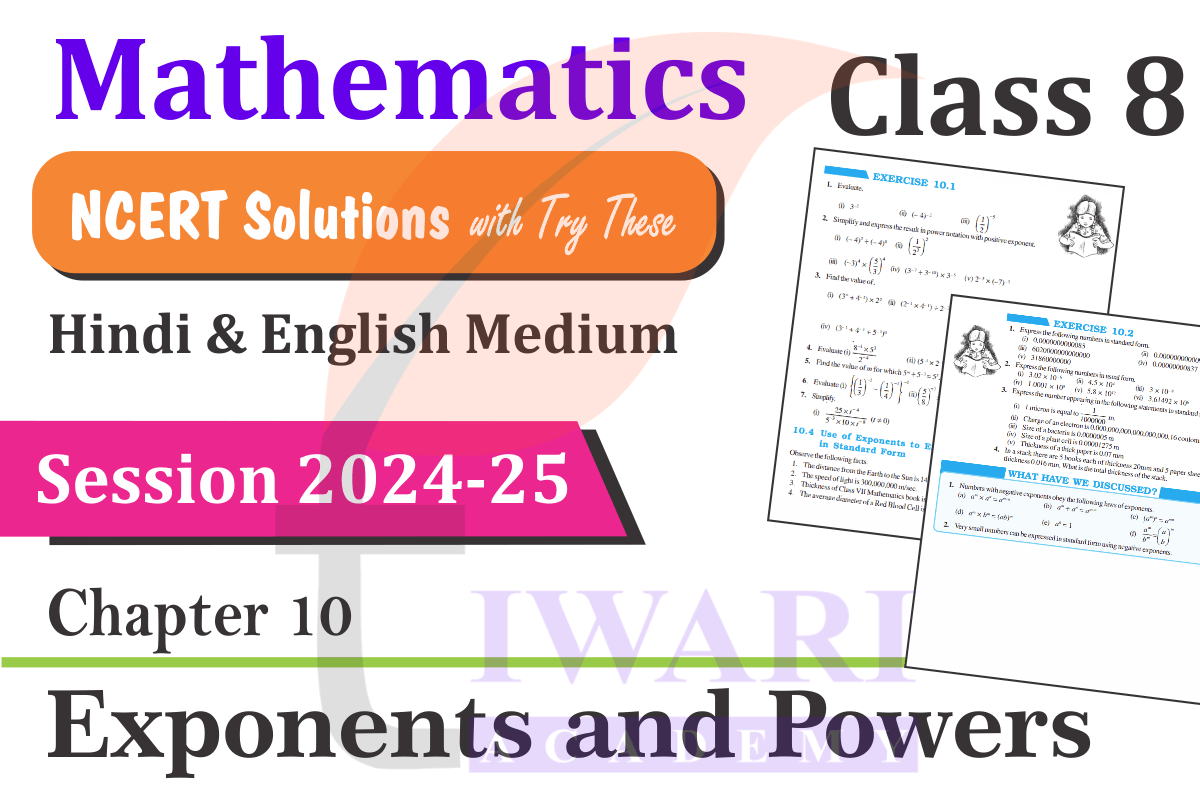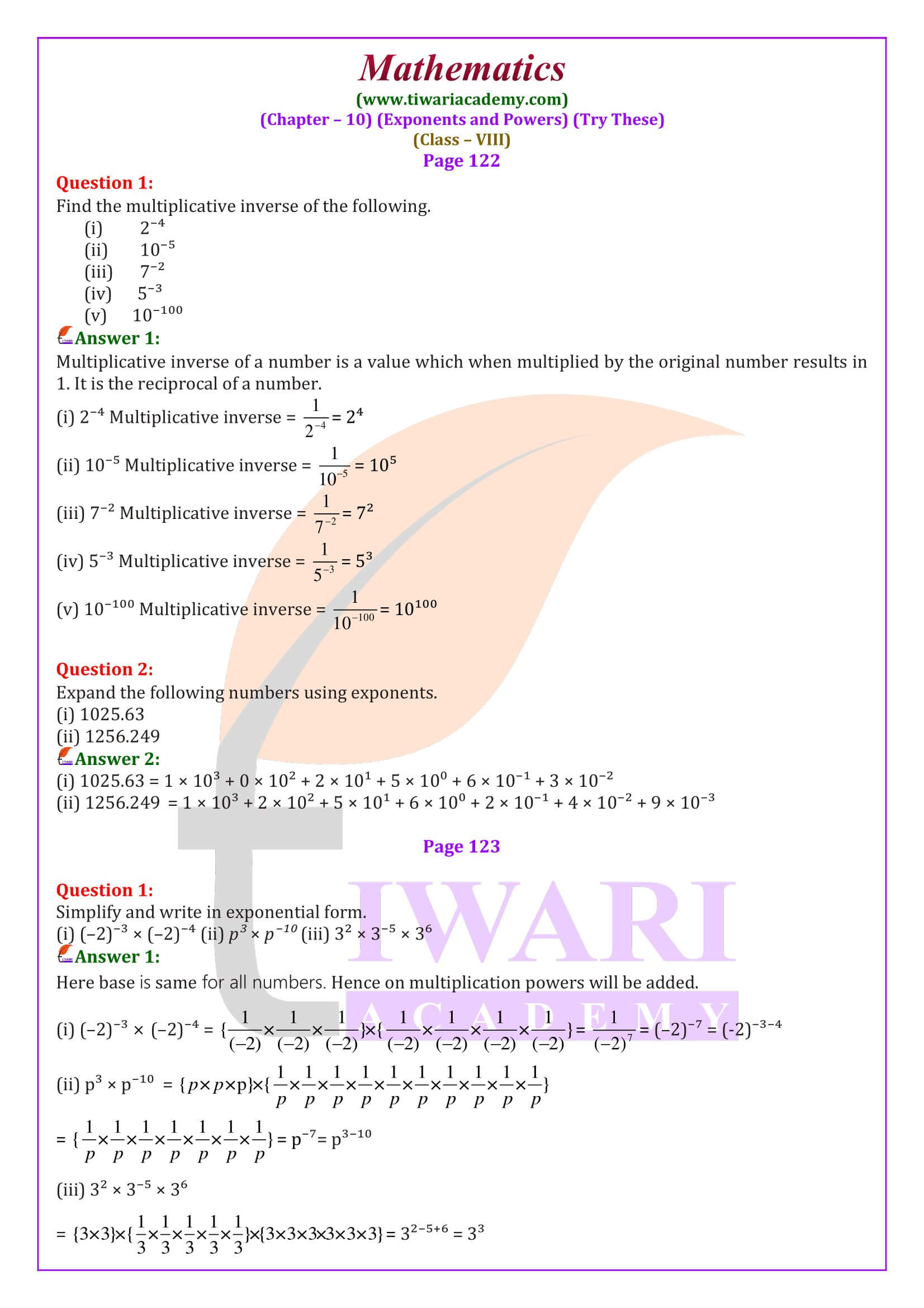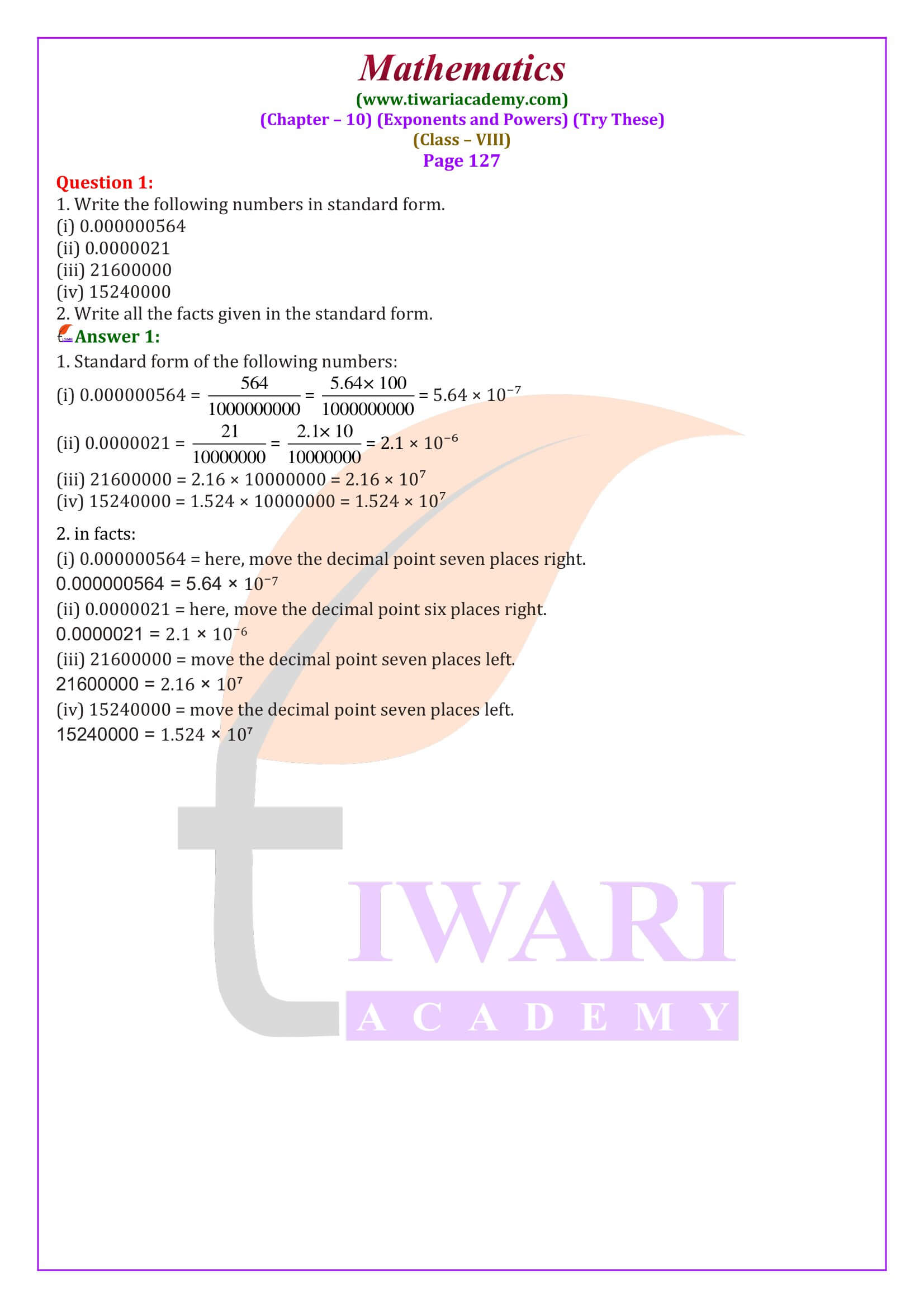NCERT Textbook Solutions for Class 8 Mathematics Chapter 10 Exponents and Powers and Class 8 Maths Chapter 10 Try these solution in Hindi and English Medium for 2025-26 CBSE exams. According to latest NCERT books, there are two exercises in chapter 10 of class 8 mathematics Solutions. NCERT Updated Solutions for Class 8 Mathematics Chapter 10, Exponents and Powers, provide a clear understanding of the concepts essential for students. NCERT Class 8th Math chapter introduces exponential notation and explains its properties with detailed examples. NCERT Class 8 Math Textbook Chapter 10 PDF contains step-by-step solutions for each exercise, such as NCERT Book Exercise 10.1, making learning easier.
NCERT Exercise Solutions for Class 8 Maths Chapter 10
Whether it’s simplifying expressions or solving problems involving large numbers, the Exponents and Powers Class 8 NCERT Revised Solutions cover all aspects comprehensively. Students often search for Class 8 Maths Chapter 10 NCERT Solutions PDF or Class 8 Maths Exponents and Powers Solutions to prepare effectively. These solutions are designed to help learners grasp concepts like laws of exponents and their applications in a simple manner. With NCERT Detailed Solutions for Class 8 Mathematics Chapter 10, students can confidently solve problems and excel in exams.
Class 8 Maths Chapter 10 Solutions in English Medium
For Class 8 Mathematics, NCERT Textbook Chapter 10 on Exponents and Powers is crucial for building foundational skills in math. The Exponents and Powers Class 8 NCERT Maths PDF provides detailed answers to all textbook questions. Statements like Class 8 Maths Chapter 10 Question Answers and NCERT Simplified Solutions for Class 8 Maths Exponents and Powers are frequently used by students looking for reliable resources.
With NCERT Book Class 8 Maths Chapter 10 Answers, learners can effectively tackle exercises such as 10.2, which focus on solving problems involving scientific notation. The solutions also emphasize practical applications of exponents, such as expressing large and small numbers efficiently. Whether students need help with Exponents and Powers Class 8 Exercise Solutions or Class 8 Maths Chapter 10 Exercise 10.1 Solutions, these resources ensure a thorough understanding. Such solutions boost confidence and make mastering this chapter easier.
Class 8 Maths Chapter 10 Solutions in Hindi Medium
Important Points in Class 8 Maths Chapter 10 Exponents and Powers
1. Laws of Exponents: Multiplication, division, power of a power and zero exponent.
2. Standard Form: Expressing large/small numbers.
3. Negative Exponents: Converting and simplifying.
4. Applications: Real-world problems using exponents.
5. Simplification: Step-by-step methods for solving complex expressions.
| Day | Topics to Cover | Exercises | Time |
|---|---|---|---|
| Day 1 | Introduction to Exponents | Exercise 10.1 | 2 hours |
| Day 2 | Laws of Exponents | Exercise 10.2 | 2.5 hours |
| Day 3 | Negative Exponents | Exercise 10.3 | 2 hours |
| Day 4 | Standard Form | Exercise 10.4 | 2.5 hours |
| Day 5 | Revision and Practice | All Exercises | 3 hours |
Students seeking a deeper Mathematical understanding of Exponents and Powers can rely on Class 8 NCERT Mathematics Chapter 10 NCERT Revised Textbook Solutions PDF for accurate answers. These solutions are meticulously crafted to address each concept and problem in the NCERT Math textbook. Topics such as the laws of exponents and their applications are explained with clarity. Searches like Exponents and Powers Class 8 Maths Chapter Solutions or Class 8 Maths Chapter 10 NCERT PDF Download lead to resources that simplify complex topics.
NCERT Textbook Exercise 10.1 and CBSE Book Exercise 10.2 are solved systematically in the Exponents and Powers Class 8 NCERT Mathematics Book Solutions, ensuring no step is missed. The NCERT Complete Solutions for Class 8 Maths Chapter 10 Free PDF format makes it convenient for students to access and study anytime. By mastering these exercises, students can strengthen their problem-solving skills and excel academically.
| Class: 8 | Mathematics |
| Chapter 10: | Exponents and Powers |
| Number of Exercises: | 2 (Two) |
| Content: | Textbook Exercises Solution |
| Mode of content: | Onlinle Text and Videos |
| Session: | Year 2025-26 |
| Medium: | English and Hindi Medium |
NCERT Solutions for Class 8 Maths Chapter 10
Get answers of 8th Maths NCERT Exercise 10.1 and Exercise 10.2 in PDF and Video. Free English and Hindi Medium solutions well updated for session 2025-26. It follows the CBSE Syllabus for new session. Download Prashnavali 10.1 and 10.2 in Hindi Medium. Tiwari Academy 8th Mathematics Solutions follow the new CBSE pattern. It is free for all the users. We work on the latest NCERT Books. Use Video solutions to get better for school exams.

Class 8 Maths Chapter 10 Solutions
Class 8 Maths Chapter 10 Exponents and Powers all exercises in English Medium as well as Hindi Medium are given to download in PDF format. For any inconvenience regarding website, please call us, we will immediately solve the problem.
Important Terms about Class 8 Maths Chapter 10
In a stack there are 5 books each of thickness 20 mm and 5 paper sheets each of thickness 0.016 mm. What is the total thickness of the stack?
Thickness of one book = 20 mm
Thickness of 5 books = 20 x 5 = 100 mm
Thickness of one paper = 0.016 mm
Thickness of 5 papers = 0.016 x 5 = 0.08 mm
Total thickness of a stack = 100 + 0.08
= 100.08 mm
= 1.0008 x 10^2 mm
The charge of an electron is 0.000,000,000,000,000,000,16 coulomb. Express this number in standard form.
Charge of an electron is 0.00000000000000000016 coulombs.
= 0.00000000000000000016 x [10^19/10^19] coulombs
= 1.6 x 10^(-19) coulombs

In Chapter 10 Exponents and Powers, we will go through the questions based rules of addition, subtraction of exponents, converting power notation in to expanded form or expanded form to exponents notations. Exercise 10.2 consists of questions related to expression in scientific form to decimal and decimal to scientific form. This chapter is easier as compared to other one but it is important as per Algebraic Expressions point of view.
More about Powers
We will learn here about exponents and powers of numbers. Questions to revise exponents are easy to solve. Chapter 10 of grade 8 gives a perfect practice of exponents. First we have to learn about exponents. After doing, exponents, focus on powers. In many sums, exponents and powers both are present. The exercises are simple to do. Focus on NCERT Books only. It has all types of sums to do. Take help from video and PDF. Solve all the terms by own. First complete NCERT Textbook Exercise 10.1 then move to next.
Topics Covered in NCERT Solutions for Class 8 Maths Chapter 10 Exponents and Powers
The NCERT Updated Solutions for Class 8 Mathematics Chapter 10 Exponents and Powers cover all the fundamental concepts related to exponents, their laws and applications. Topics include representing large and small numbers using exponential notation and simplifying complex expressions. Solutions for NCERT Textbook exercises like 10.1 and 10.2 are presented step-by-step, ensuring a comprehensive understanding. Students can use these solutions to practice Exponents and Powers Class 8 Exercise Solutions and Class 8 Maths Chapter 10 NCERT Solutions PDF. This resource provides clarity on properties such as the multiplication and division of exponents, making it an essential tool for exam preparation.
Where can I find a reliable Class 8 Maths Chapter 10 NCERT Solutions PDF?
Reliable resources for Exponents and Powers are available as Class 8 Maths Chapter 10 NCERT Solutions PDF, which can be downloaded from educational websites like Tiwari Academy or online platforms. These PDFs include solutions to all textbook exercises, like Exponents and Powers Class 8 Chapter Solutions and Class 8 Maths Chapter 10 NCERT Exercise 10.1 Solutions. Designed by subject experts, they ensure accurate answers and explanations. NCERT Solutions for Class 8 Mathematics Exponents and Powers are ideal for students preparing for exams, as they address every question from the textbook in detail, making complex problems easy to understand.
How do NCERT Class 8 Maths Chapter 10 Solutions help with exam preparation?
The NCERT Class 8 Mathematics Textbook Chapter 10 Exercise Solutions play a crucial role in exam preparation by providing step-by-step explanations for every problem in the chapter Exponents and Powers. These solutions include Exponents and Powers Class 8 NCERT Book Solutions for exercises 10.1 and 10.2, ensuring that students have complete clarity on concepts. By practicing Class 8 Maths Exponents and Powers Solutions, learners develop a strong foundation in exponential laws and applications. These resources also help students tackle Class 8 Maths Chapter 10 Question Answers confidently, allowing them to score better in exams.
What makes Exponents and Powers Class 8 NCERT Solutions effective for learning?
Exponents and Powers Class 8 NCERT Textbook Solutions are effective because they simplify complex topics through detailed explanations and examples. They cover all exercises, including 10.1 and 10.2, ensuring students understand every concept thoroughly. Topics like the laws of exponents are explained clearly in the Class 8 Maths Chapter 10 NCERT PDF. Solutions such as Exponents and Powers Class 8 Exercise Solutions are presented in an easy-to-follow format, making them accessible for self-study. These resources are tailored to address the common challenges students face, enabling them to practice effectively and improve their problem-solving skills.
Can I download NCERT Solutions for Class 8 Maths Chapter 10 for free?
Yes, you can download the NCERT Modified Solutions for Class 8 Maths Chapter 10 Free PDF from Tiwari Academy and other various educational platforms. These free resources include solutions for exercises like Class 8 Maths Chapter 10 Exercise 10.1 Solutions and Exponents and Powers Class 8 Chapter Solutions, ensuring comprehensive coverage of all topics. The Class 8 Mathematics Chapter 10 NCERT PDF Download option is convenient for students who prefer offline study. With these free PDFs, learners gain access to step-by-step solutions and explanations, making it easier to master Exponents and Powers and excel in exams without incurring additional costs.






